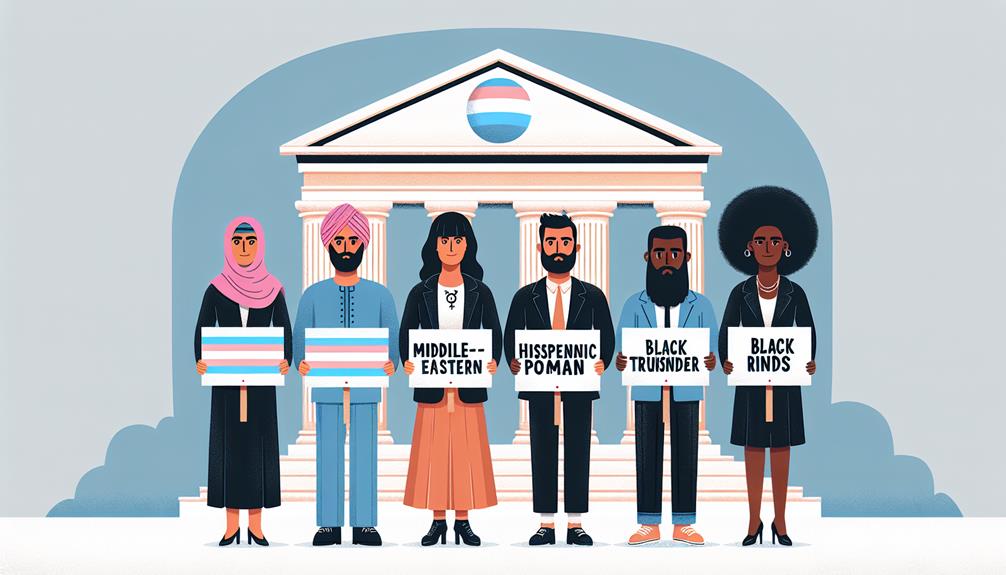
Leveraging inclusive education environments as a powerful strategy for trans policy change can reshape societal attitudes and behaviors, leading to a more inclusive future.
Table of Contents
ToggleOne powerful strategy for trans policy change is the implementation of inclusive education environments that support and affirm transgender students. By creating safe and welcoming spaces in schools, students are better able to thrive and succeed.
It's crucial to recognize the impact of such strategies on fostering a more inclusive society. These strategies not only address immediate policy concerns but also have the potential to reshape societal attitudes and behaviors.
Understanding the multifaceted nature of trans policy change is essential for creating meaningful and lasting impact.
Key Takeaways
- Grassroots activism is crucial for advocating for change and addressing barriers to healthcare, education, and employment for transgender individuals.
- Legal advocacy plays a significant role in securing legal protections and recognition of gender identity, as well as providing representation for transgender individuals facing discrimination.
- Public awareness campaigns are essential for educating and challenging stereotypes about transgender issues, and collaboration with transgender individuals and organizations is crucial for inclusive and accurate messaging.
- Coalition building is necessary for amplifying the impact of advocacy efforts, as it involves collaborating with diverse organizations and individuals to establish common goals and strategies for meaningful policy change.
Grassroots Activism
Grassroots activism empowers communities to organize and advocate for social or political change from the ground up, amplifying their voices and shaping policies that directly impact their lives.
Within the realm of transgender rights, grassroots activism plays a crucial role in advocating for inclusive policies and nondiscrimination laws. The National Center for Transgender Equality and Allies of Transgender individuals often spearhead grassroots efforts to support transgender and non-binary individuals.
These efforts aim to address the barriers to accessing healthcare, education, and employment that transgender individuals often face due to discrimination based on their gender identity.
Grassroots activism also focuses on building awareness and mobilizing support for Gender Identity (SOGI) policies, which are essential for protecting the rights of transgender individuals.
Legal Advocacy
While grassroots activism mobilizes communities for change, legal advocacy utilizes the legal system to protect and advance the rights of transgender individuals, encompassing activities such as litigation and legal counseling. Legal advocacy plays a crucial role in securing legal protections for the transgender community, including anti-discrimination laws, access to basic healthcare, and recognition of gender identity. It also involves impact litigation to challenge discriminatory laws and policies, shaping and enforcing policies that promote equality and justice for transgender people.
In recent years, legal advocacy has been instrumental in landmark cases before the Supreme Court, setting important precedents for transgender rights. These cases have addressed issues such as discrimination in the workplace and access to gender-affirming healthcare, significantly impacting the lives of transgender individuals.
Legal advocacy also provides vital representation for transgender individuals facing discrimination or seeking gender-affirming healthcare, ensuring that their rights are upheld and protected under the law.
Public Awareness Campaigns
Public awareness campaigns play a crucial role in educating and informing the general population about transgender issues and experiences. These campaigns are essential for challenging stereotypes, promoting understanding, and reducing discrimination against trans people. To be effective, public awareness campaigns need to utilize diverse media platforms and engage with various communities to reach a wider audience.
Messaging in these campaigns should be inclusive, respectful, and accurate to ensure a positive impact and change in public attitudes towards gender diverse individuals. It's also crucial to collaborate with transgender individuals and organizations when developing and implementing these campaigns to ensure that the content accurately represents the experiences and challenges faced by the trans community.
Coalition Building
To effectively advance transgender policy change, building coalitions with diverse organizations and groups is essential for amplifying the impact of advocacy efforts and unifying strategies to promote trans rights.
By collaborating with a wide range of stakeholders, including trans individuals, allies, community leaders, and organizations focused on Sexual Orientation and Gender, the trans community can address discrimination and barriers more effectively.
Coalition building allows for the pooling of resources and expertise, creating a stronger and more influential voice for trans advocacy.
Establishing common goals and strategies within these coalitions is crucial for unifying efforts and advocating for meaningful policy change.
Moreover, fostering relationships with key stakeholders both within and beyond the trans community helps to build solidarity and support, amplifying the reach and impact of the advocacy work.
Policy Reform Efforts
Collaborating with organizations advocating for policy changes and legal protections for transgender individuals, the focus now shifts to discussing policy reform efforts as a means to achieve trans liberation and promote trans-inclusive policies and practices. Policy reform plays a crucial role in addressing the systemic challenges faced by transgender people and ensuring their rights and well-being.
Here are some key policy reform efforts that can significantly impact the lives of transgender individuals:
- Legal Protections: Advocating for comprehensive legal protections for gender identity and expression to safeguard transgender individuals from discrimination in various sectors including employment, education, and housing.
- Healthcare Access: Pushing for policies that ensure access to gender-affirming medical care, hormone therapy, and reproductive health services, thereby improving the overall health outcomes of transgender individuals.
- Law Enforcement Policies: Working towards implementing trans-inclusive policies within law enforcement agencies to ensure fair and respectful treatment of transgender individuals within the criminal justice system.
- Economic Opportunities: Advocating for policies that promote equal economic opportunities and combat employment discrimination based on gender identity, thereby fostering financial stability within the transgender community.
These policy reform efforts are essential in creating a more inclusive and equitable society for transgender individuals, addressing systemic injustices, and promoting their overall well-being and empowerment.
Frequently Asked Questions
What Are the Interventions for Gender Transition?
Interventions for gender transition include:
- Hormone therapy
- Gender-affirming surgeries
- Counseling
- Legal changes like updating identification documents and changing names
- Voice training
- Gender expression coaching
These interventions support individuals in their gender transition process. Additionally, support from friends, family, and the community is crucial.
These interventions aim to help individuals align their physical appearance, legal identity, and social interactions with their gender identity.
What Are the First Steps to Transitioning Mtf?
The first steps to transitioning mtf typically involve seeking guidance from a gender therapist.
Educating oneself about the transition process is also an important step.
Connecting with the transgender community for support can provide valuable insights and a sense of belonging.
Considering hormone replacement therapy (HRT) under medical supervision is another common step in the transition process.
Exploring different presentation styles to express one's gender identity is also an important aspect of transitioning.
These initial steps can provide individuals with a foundation for navigating their gender transition journey and accessing the resources they need for support and guidance.
What Is the Best Age to Transition Mtf?
Determining the best age to transition MTF is a deeply personal decision. While physical outcomes may be more favorable at a younger age, emotional readiness is equally important.
Factors to consider include personal, social, and medical aspects. Seeking guidance from healthcare professionals and the transgender community can provide valuable insight.
Ultimately, the best age to transition MTF is when an individual feels ready and supported in their decision.
How Can You Respect Gender Variance in the Workplace?
Respecting gender variance in the workplace involves:
- Using a person's chosen name and pronouns.
- Listening to and acknowledging others' use of pronouns.
- Refraining from asking intrusive questions about surgical status.
It also requires:
- Advocating for all-gender restroom options.
- Educating oneself and others about transgender issues.
These actions create a more inclusive and respectful work environment for all individuals, regardless of their gender identity.
Conclusion
In conclusion, the powerful strategies for trans policy change are like a superhero team fighting for justice and equality.
With grassroots activism, legal advocacy, public awareness campaigns, coalition building, and policy reform efforts, they're taking on discrimination and inequality to create a more inclusive society.
It's like the Avengers assembling to tackle the biggest challenges facing transgender individuals, and with these strategies, they're making real progress towards trans liberation.
Originally posted 2024-01-30 16:35:55.
Profile Author / Editor / Publisher
- Dora Saparow
- Dora Kay Saparow came out in a conservative Nebraskan town where she faced both misunderstanding and acceptance during her transition. Seeking specialized support, she moved to a big city, where she could access the medical, legal, and social resources necessary for her journey. Now, twelve years later, Dora is fully transitioned, happily married, and well-integrated into society. Her story underscores the importance of time, resources, and community support, offering hope and encouragement to others pursuing their authentic selves.
Latest entries
 Featured PostsDecember 31, 2025Beyond the Headlines: The Full Impact of New Anti-Trans Laws
Featured PostsDecember 31, 2025Beyond the Headlines: The Full Impact of New Anti-Trans Laws Featured PostsDecember 30, 2025Misgendered by Machines: Inside AI’s Discrimination Against Trans People and the Solutions We Need
Featured PostsDecember 30, 2025Misgendered by Machines: Inside AI’s Discrimination Against Trans People and the Solutions We Need News and AdvocacyDecember 21, 2025In Prime-Time Speech, Trump’s Anti-Trans Broadsides Are Branded as Desperate
News and AdvocacyDecember 21, 2025In Prime-Time Speech, Trump’s Anti-Trans Broadsides Are Branded as Desperate Featured PostsDecember 21, 2025Beyond the Binary: A Basic Guide to Transgender Awareness
Featured PostsDecember 21, 2025Beyond the Binary: A Basic Guide to Transgender Awareness





























